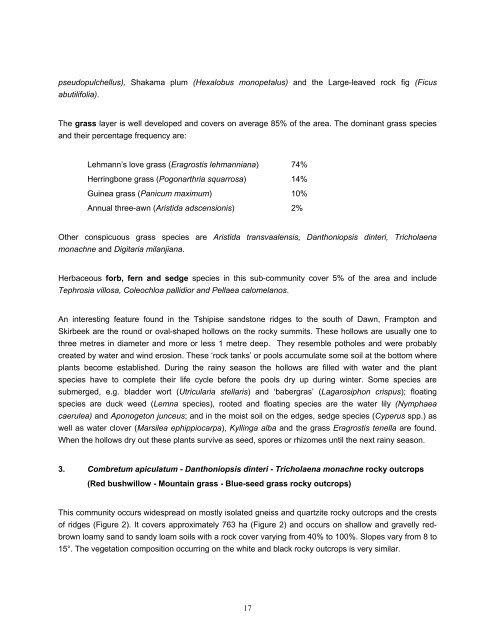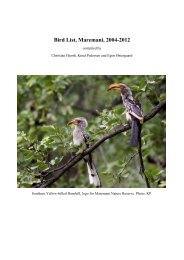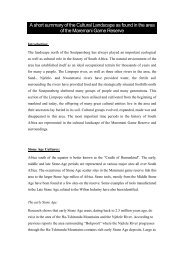the vegetation types and veld condition - Maremani Nature Reserve
the vegetation types and veld condition - Maremani Nature Reserve
the vegetation types and veld condition - Maremani Nature Reserve
Create successful ePaper yourself
Turn your PDF publications into a flip-book with our unique Google optimized e-Paper software.
pseudopulchellus), Shakama plum (Hexalobus monopetalus) <strong>and</strong> <strong>the</strong> Large-leaved rock fig (Ficus<br />
abutilifolia).<br />
The grass layer is well developed <strong>and</strong> covers on average 85% of <strong>the</strong> area. The dominant grass species<br />
<strong>and</strong> <strong>the</strong>ir percentage frequency are:<br />
Lehmann’s love grass (Eragrostis lehmanniana) 74%<br />
Herringbone grass (Pogonarthria squarrosa) 14%<br />
Guinea grass (Panicum maximum) 10%<br />
Annual three-awn (Aristida adscensionis) 2%<br />
O<strong>the</strong>r conspicuous grass species are Aristida transvaalensis, Danthoniopsis dinteri, Tricholaena<br />
monachne <strong>and</strong> Digitaria milanjiana.<br />
Herbaceous forb, fern <strong>and</strong> sedge species in this sub-community cover 5% of <strong>the</strong> area <strong>and</strong> include<br />
Tephrosia villosa, Coleochloa pallidior <strong>and</strong> Pellaea calomelanos.<br />
An interesting feature found in <strong>the</strong> Tshipise s<strong>and</strong>stone ridges to <strong>the</strong> south of Dawn, Frampton <strong>and</strong><br />
Skirbeek are <strong>the</strong> round or oval-shaped hollows on <strong>the</strong> rocky summits. These hollows are usually one to<br />
three metres in diameter <strong>and</strong> more or less 1 metre deep. They resemble potholes <strong>and</strong> were probably<br />
created by water <strong>and</strong> wind erosion. These ‘rock tanks’ or pools accumulate some soil at <strong>the</strong> bottom where<br />
plants become established. During <strong>the</strong> rainy season <strong>the</strong> hollows are filled with water <strong>and</strong> <strong>the</strong> plant<br />
species have to complete <strong>the</strong>ir life cycle before <strong>the</strong> pools dry up during winter. Some species are<br />
submerged, e.g. bladder wort (Utricularia stellaris) <strong>and</strong> ‘babergras’ (Lagarosiphon crispus); floating<br />
species are duck weed (Lemna species), rooted <strong>and</strong> floating species are <strong>the</strong> water lily (Nymphaea<br />
caerulea) <strong>and</strong> Aponogeton junceus; <strong>and</strong> in <strong>the</strong> moist soil on <strong>the</strong> edges, sedge species (Cyperus spp.) as<br />
well as water clover (Marsilea ephippiocarpa), Kyllinga alba <strong>and</strong> <strong>the</strong> grass Eragrostis tenella are found.<br />
When <strong>the</strong> hollows dry out <strong>the</strong>se plants survive as seed, spores or rhizomes until <strong>the</strong> next rainy season.<br />
3. Combretum apiculatum - Danthoniopsis dinteri - Tricholaena monachne rocky outcrops<br />
(Red bushwillow - Mountain grass - Blue-seed grass rocky outcrops)<br />
This community occurs widespread on mostly isolated gneiss <strong>and</strong> quartzite rocky outcrops <strong>and</strong> <strong>the</strong> crests<br />
of ridges (Figure 2). It covers approximately 763 ha (Figure 2) <strong>and</strong> occurs on shallow <strong>and</strong> gravelly red-<br />
brown loamy s<strong>and</strong> to s<strong>and</strong>y loam soils with a rock cover varying from 40% to 100%. Slopes vary from 8 to<br />
15°. The <strong>vegetation</strong> composition occurring on <strong>the</strong> white <strong>and</strong> black rocky outcrops is very similar.<br />
17




